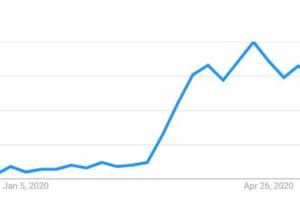In April 2020, the Center for Exhibition Industry Research (CEIR) survey of executives with oversight of U.S. B2B exhibitions found that 41% of organizers reported postponing events later in 2020 and 34% of organizers have delayed their events well into 2021. And with announcements from the likes of Salesforce and Microsoft converting all their in-person events to virtual for the remainder of 2020, it is clear COVID-19 has created uncertainty for the foreseeable future.
Don’t Pivot Your Event – Reimagine It
When I was running for a local elected office many years ago (a story for another blog post), my campaign consultants coached me on how to “pivot” during debates. In politics, it is a diversion tactic to avoid a non-advantageous topic and change the conversation to something more beneficial for the candidate. In the events business, the pivot seems to have manifested itself as a short-term solution to a long-term problem.

Google Search Term 1 – Coronavirus
To be fair, events and trade shows in the early days and weeks of the pandemic had only a few options. Since that time, it has become evident the Coronavirus is not an acute event with a clear conclusion (an organizer’s worst nightmare). To put this in perspective, below is a chart of the Google Search traffic for “virtual events” and “coronavirus” since the beginning of 2020.
Understandably, even veteran event professionals who by definition are worst-case scenario planners and they never had this in their playbook. Unfortunately, as the crisis progressed, instead of reimagining events and focusing on the core foundations of content, commerce, connections and community in the virtual world, many decided to “pivot” and abandoned many of these basic tenants.

Google Search Term 2 – Virtual Events
E-mail and voicemail boxes were flooded with messages and calls from unheard of companies with virtual event “experts” and new products offering a life raft in a rising sea. Virtual events seemed like the answer and the only answer. Organizations and associations had to be willing to give up many core components (and revenue drivers) to their event to survive (commerce, connections and community). Countless events suddenly dropped registration fees, removed their mobile app, refunded exhibitors and sponsors and focused solely on the educational components. Not only was it not sustainable to their business, but it was also not what their attendees and exhibitors wanted.
Hybrid First – Virtual Events Second Approach
So what are the answers to future proof your events in an uncertain COVID-19 world? Even if a mass producible, tested and proven vaccine becomes available, you must approach, plan and solve for the inevitable long-term changes. Sounds daunting or impossible, right?
I do not see it this way. Everyone agrees that both the benefits and desire to meet in-person will propel the industry forward. That yearning for face-to-face interactions may even create new opportunities we have yet to imagine (or monetize). In parallel, the demand or need to consume and experience events in a virtual world will remain.
In this hybrid approach, cost centers, revenue streams and time commitments diversify, mitigate risk and maximize investment and engagement for every participant. Attendees, exhibitors, speakers, organizers, event staff and many others can evaluate participation in new ways. New opportunities will also be created by a hybrid model that is not possible with an in-person or virtual event.
Furthermore, creative organizers will blur the lines between virtual and in-person to provide highly valuable experiences, including content, connections, commerce and community for every constituent in the lifecycle of an event.
Community–Driven Events
The other way to significantly future proof your event is around developing events–focused communities. I have conducted hundreds of focus groups in my career and every attendee and exhibitor has shared similar sentiments:
- “I wish there was a way to engage, participate or connect before and after the event.”
- “Why do I only get to share my latest products and services with this audience for three days? There is so much pressure to deliver high levels of quality leads in such a short time frame.”
- “This event would be more valuable to my boss if I could continue connecting and learning from the others in these sessions.”
We (as show organizers) are laser focused on the achievements that must happen in a three– to five-day time period. We completely understand and have often talked about the fact that engagement is needed year-round to drive better satisfaction. We have not concentrated on it since our in-person events always happens. Always. Until now.
When COVID hit—suddenly—shifting the risks (and rewards) across the entire year seems far more plausible (and even more satisfying for everyone involved).
Imagine having attendees, speakers, staff, exhibitors/sponsors and thought leaders all exchanging ideas, discussing challenges and solving problems before the event. Exhibitors having already shared their white papers and research to benefit attendees (and their companies). Attendees having already connected and reviewed new products or services and had engagement around an industry topic with those exhibitors and sponsors.
Think about driving registration trends earlier so registrants could take advantage of this community (hello FOMO). All of this before a badge is even printed.
And finally, the in-person event where this engaged community meets face to face will still be connected in the hybrid world to those attending virtually and each more satisfied by their choices. And after the event, everyone convenes again to further the learnings well into next year’s event or drives them to another meeting or event that you are holding. Suddenly the investment is year-long, the risk far less to the organizer and the experience far greater.
 Back to Basics
Back to Basics
So before you pivot and completely change directions, remember that the vision for a successful event is a foundation of connecting people with content, each other (in a community) and commerce.
Most of you do that really well with the talent you already have on your team, your industry partners and technology in your ecosystem and the audience that already believes in what you do.
Your event must go on and when the “months of March 2020” finally end, being ready with a hybrid approach and an event community in-place will serve everyone in the long-term. Your convention, hotel and education rooms will once again be filled, some virtually and many in person.
Don’t pivot, reimagine for the long-term. Want to learn more?
Watch our on-demand webinar for best practices on how to plan successful (and profitable) virtual hybrid events including:
- Creating Engagement – In a virtual or hybrid events environment, creating connections and building community will be paramount to event success.
- Harnessing Event Tech – Most registrants have never attended, or companies ever exhibited at a virtual or hybrid event. Building and communicating an experience using your event website, mobile app and other event tech tools is critical.
- Developing Commerce – Regardless of the forum (in-person or hybrid), connecting buyers and suppliers (and other attendees) is paramount for most trade shows and events. Learn how to create a frictionless environment that fosters these connections required for profitable events (and satisfied exhibitors and sponsors).
- Engaging Content – Simply taking in-person content (and the associated speakers) and serving it in a digital environment will not be valuable or engaging. Creating a virtual program requires additional thought and considerations that don’t exist in the in-person world.

 Back to Basics
Back to Basics